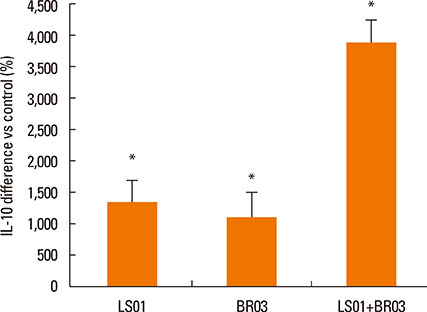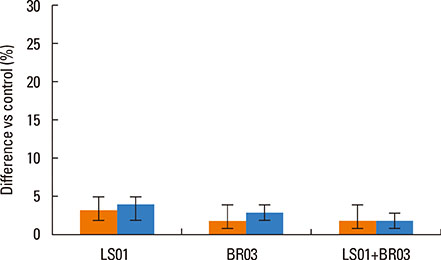Allergy Asthma Immunol Res.
2015 Jul;7(4):409-413. 10.4168/aair.2015.7.4.409.
Immunomodulatory Effects of Lactobacillus salivarius LS01 and Bifidobacterium breve BR03, Alone and in Combination, on Peripheral Blood Mononuclear Cells of Allergic Asthmatics
- Affiliations
-
- 1Laboratory of Technical Sciences for Laboratory Medicine, Department of Biomedical Science for Health, University of Milan, Milan, Italy. lorenzo.drago@unimi.it
- 2Laboratory of Clinical Chemistry and Microbiology, IRCCS Galeazzi Orthopaedic Institute, Milan, Italy.
- KMID: 2166689
- DOI: http://doi.org/10.4168/aair.2015.7.4.409
Abstract
- The aim of this study was to evaluate probiotic characteristics of Lactobacillus salivarius LS01 and Bifidobacterium breve BR03 alone and in combination and their immunomodulatory activity in asthmatic subjects. Subjects affected by allergic asthma were recruited. Initially, LS01 and BR03 were analyzed for their growth compatibility by a broth compatibility assay. To study the antimicrobial activity of probiotic strains, an agar diffusion assay was performed. Finally, cytokine production by peripheral blood mononuclear cells (PBMCs) stimulated with LS01 and BR03 was determined by means of specific quantitative enzyme-linked immunosorbent assay (ELISA). The growth of some clinical pathogens were slightly inhibited by LS01 and LS01-BR03 co-culture supernatant not neutralized to pH 6.5, while only the growth of E. coli and S. aureus was inhibited by the supernatant of LS01 and LS01-BR03 neutralized to pH 6.5. Furthermore, LS01 and BR03 combination was able to decrease the secretion of proinflammatory cytokines by PBMCs, leading to an intense increase in IL-10 production. L. salivarius LS01 and B. breve BR03 showed promising probiotic properties and beneficial immunomodulatory activity that are increased when the 2 strains are used in combination in the same formulation.
Keyword
MeSH Terms
Figure
Cited by 1 articles
-
Minocycline and Its Impact on Microbial Dysbiosis in the Skin and Gastrointestinal Tract of Acne Patients
Katherine G. Thompson, Barbara M. Rainer, Corina Antonescu, Liliana Florea, Emmanuel F. Mongodin, Sewon Kang, Anna L. Chien
Ann Dermatol. 2020;32(1):21-30. doi: 10.5021/ad.2020.32.1.21.
Reference
-
1. Björkstén B. Environmental risk factors for atopy. Clin Rev Allergy Immunol. 1997; 15:125–143.2. Björkstén B. The environmental influence on childhood asthma. Allergy. 1999; 54:Suppl 49. 17–23.3. Julge K, Vasar M, Björkstén B. The development of atopic sensitization in Estonian infants. Acta Paediatr. 1997; 86:1188–1194.4. Robinson DS, Kay AB. Role of Th1 and Th2 cells in human allergic disorders. Chem Immunol. 1996; 63:187–203.5. Isolauri E, Salminen S. Nutrition, Allergy, Mucosal Immunology, and Intestinal Microbiota (NAMI) Research Group Report. Probiotics: use in allergic disorders: a Nutrition, Allergy, Mucosal Immunology, and Intestinal Microbiota (NAMI) Research Group Report. J Clin Gastroenterol. 2008; 42:Suppl 2. S91–S96.6. Gourbeyre P, Denery S, Bodinier M. Probiotics, prebiotics, and synbiotics: impact on the gut immune system and allergic reactions. J Leukoc Biol. 2011; 89:685–695.7. Drago L, Toscano M, Pigatto PD. Probiotics: immunomodulatory properties in allergy and eczema. G Ital Dermatol Venereol. 2013; 148:505–514.8. Food and Agriculture Organization of the United Nations (IT). World Health Organization (CH). Guidelines for the evaluation of probiotics in food. Report of a joint FAO/WHO Working Group on drafiting guidelines for the evaluation of probiotics in food. Rome: Food and Agriculture Organization of the United Nations;2002.9. Iemoli E, Trabattoni D, Parisotto S, Borgonovo L, Toscano M, Rizzardini G, et al. Probiotics reduce gut microbial translocation and improve adult atopic dermatitis. J Clin Gastroenterol. 2012; 46:Suppl. S33–S40.10. Mueller C, Macpherson AJ. Layers of mutualism with commensal bacteria protect us from intestinal inflammation. Gut. 2006; 55:276–284.11. Ramakrishna BS. Probiotic-induced changes in the intestinal epithelium: implications in gastrointestinal disease. Trop Gastroenterol. 2009; 30:76–85.12. Pessi T, Sütas Y, Hurme M, Isolauri E. Interleukin-10 generation in atopic children following oral Lactobacillus rhamnosus GG. Clin Exp Allergy. 2000; 30:1804–1808.13. Kilpi T, Kero J, Jokinen J, Syrjänen R, Takala AK, Hovi T, et al. Common respiratory infections early in life may reduce the risk of atopic dermatitis. Clin Infect Dis. 2002; 34:620–626.14. Drago L, Nicola L, Iemoli E, Banfi G, De Vecchi E. Strain-dependent release of cytokines modulated by Lactobacillus salivarius human isolates in an in vitro model. BMC Res Notes. 2010; 3:44.15. Gore C, Custovic A, Tannock GW, Munro K, Kerry G, Johnson K, et al. Treatment and secondary prevention effects of the probiotics Lactobacillus paracasei or Bifidobacterium lactis on early infant eczema: randomized controlled trial with follow-up until age 3 years. Clin Exp Allergy. 2012; 42:112–122.16. Drago L, Toscano M, De Vecchi E, Piconi S, Iemoli E. Changing of fecal flora and clinical effect of L. salivarius LS01 in adults with atopic dermatitis. J Clin Gastroenterol. 2012; 46:Suppl. S56–S63.17. Michałkiewicz J, Stachowski J, Barth C, Patzer J, Dzierzanowska D, Madaliński K. Effect of Pseudomonas aeruginosa exotoxin A on IFN-gamma synthesis: expression of costimulatory molecules on monocytes and activity of NK cells. Immunol Lett. 1999; 69:359–366.18. Socha P, Michałkiewicz J, Stachowski J, Pawłowska J, Jankowska I, Barth C, et al. Deficiency of the expression of CD45RA isoform of CD45 common leukocyte antigen in CD4+ T lymphocytes in children with infantile cholestasis. Immunol Lett. 2001; 75:179–184.19. Robredo B, Torres C. Bacteriocin production by Lactobacillus salivarius of animal origin. J Clin Microbiol. 2000; 38:3908–3909.20. Cleveland J, Montville TJ, Nes IF, Chikindas ML. Bacteriocins: safe, natural antimicrobials for food preservation. Int J Food Microbiol. 2001; 71:1–20.21. Barrett E, Hayes M, O'Connor P, Gardiner G, Fitzgerald GF, Stanton C, et al. Salivaricin P, one of a family of two-component antilisterial bacteriocins produced by intestinal isolates of Lactobacillus salivarius. Appl Environ Microbiol. 2007; 73:3719–3723.22. Makras L, De Vuyst L. The in vitro inhibition of Gram-negative pathogenic bacteria by bifidobacteria is caused by the production of organic acids. Int Dairy J. 2006; 16:1049–1057.23. Ibrahim SA, Dharmavaram SR, Seo CW, Shahbazi G. Antimicrobial activity of Bifidobacterium longum (NCFB 2259) as influenced by spices. Int J Food Safety. 2005; 2:6–8.24. Michalkiewicz J, Krotkiewski M, Gackowska L, Wyszomirska-Golda M, Helmin-Basa A, Dzierźanowska D, et al. Immunomodulatory effects of lactic acid bacteria on human peripheral blood mononuclear cells. Microb Ecol Health Dis. 2003; 15:185–192.25. Borish L, Aarons A, Rumbyrt J, Cvietusa P, Negri J, Wenzel S. Interleukin-10 regulation in normal subjects and patients with asthma. J Allergy Clin Immunol. 1996; 97:1288–1296.26. Schmidt-Weber CB, Blaser K. The role of TGF-beta in allergic inflammation. Immunol Allergy Clin North Am. 2006; 26:233–244. vi–vii.27. Wong CK, Ho CY, Ko FW, Chan CH, Ho AS, Hui DS, et al. Proinflammatory cytokines (IL-17, IL-6, IL-18 and IL-12) and Th cytokines (IFN-gamma, IL-4, IL-10 and IL-13) in patients with allergic asthma. Clin Exp Immunol. 2001; 125:177–183.28. Pochard P, Gosset P, Grangette C, Andre C, Tonnel AB, Pestel J, et al. Lactic acid bacteria inhibit TH2 cytokine production by mononuclear cells from allergic patients. J Allergy Clin Immunol. 2002; 110:617–623.
- Full Text Links
- Actions
-
Cited
- CITED
-
- Close
- Share
- Similar articles
-
- Immunomodulatory and antitumor effects in vivo by the cytoplasmic fraction of Lactobacillus casei and Bifidobacterium longum
- Intestinal Microbiota and the Development of Allergy in Infants
- The immune enhancing effects and characteristics of Bifidobacterium longum and Bifidobacterium breve for the probiotic use in humans and animals
- Functional Changes of Interleukin-4 and Interferon-gamma of Peripheral Blood and Nasal Mucosa after Immunotherapy in Patients with Perennial Allergic Rhinitis
- The Changes in the Breath Hydrogen Concentration after the Ingestion of Bifidobacterium breve KY-16 in the Lactose Malabsorbers




